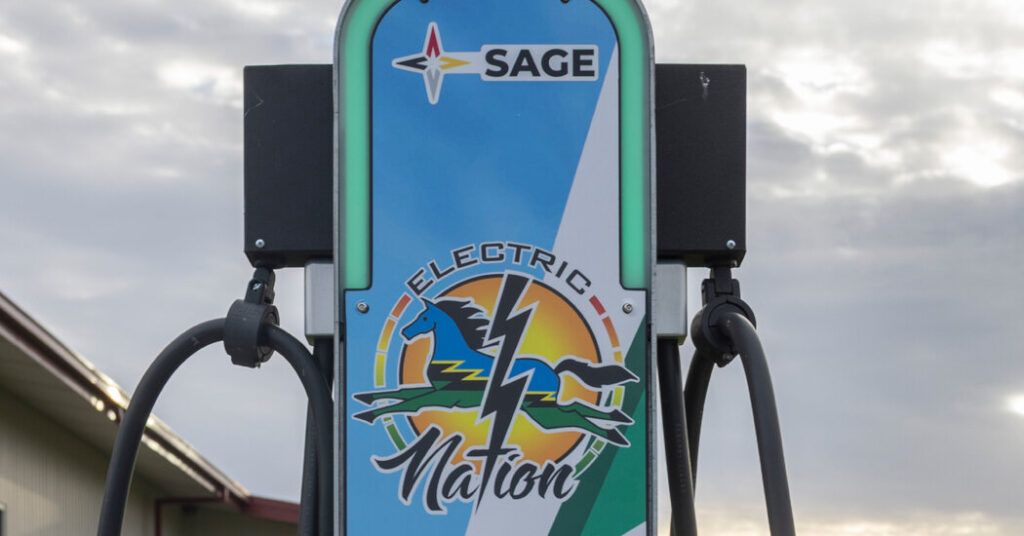This summer, Len Necefer finally planned the road trip he’s been thinking about for nearly a decade: Going coast-to-coast in an electric vehicle, stopping only to charge on tribal lands.
As a Navajo citizen and tribal energy expert who used to work in the federal government, he saw it as the ultimate test of how far energy infrastructure had come.
Stop by stop, his plans came together until North Dakota, where a dearth of chargers seemed to prevent a Midwest crossing. Then, he spotted it: a level-2 charger at Sitting Bull College on the Standing Rock Reservation.
50 States, 50 Fixes is a series about local solutions to environmental problems. A few more to come this year.
It was more than a lucky break. Over the past three years, Standing Rock has installed chargers across the reservation as part of the Electric Nation project, a regional effort to create an intertribal charging network.
By the time the project wraps at the end of November, Standing Rock Nation will operate 13 E.V. chargers, most of them in North Dakota. While there aren’t many E.V.s in town yet, each new charger makes driving one easier than before.
“I want to show folks that this technology is not out of our affordable reach, but that it is here for us to use,” said Joseph McNeil, the chief executive of SAGE, a clean energy organization owned by the tribe that is spearheading the project.
The Standing Rock Reservation, home to the Lakota and Dakota peoples, is rural and spread out, straddling the border between North and South Dakota. The cost of gas aggravates the reservation’s high poverty rates. With the closest commercial centers at least an hour away, access to reliable transportation is a measure of well being.
“Our economic situation shouldn’t dictate our access to sustainability,” Mr. McNeil said. He wants every SAGE project to create jobs or revenue for the tribe. Institutions that are hosting the E.V. chargers, like the college, will eventually take ownership of them and collect any revenue.
SAGE’s project director, Fawn Wasin Zi, said E.V.s were part of a longstanding push for clean energy on the reservation. In 2016, the tribe was in the midst of planning a wind farm when protests to block the Dakota Access Pipeline engulfed the reservation. Their fight against a plan to transport oil over their sacred lands was recognized with an award from the Wallace Global Fund, which came with a $250,000 prize and a $1 million investment earmarked for the ongoing wind farm project.
The tribe may be widely known for the anti-pipeline movement, Ms. Wasin Zi said, “but there’s so much more going on.” She was managing the wind project at the time and used the prize to start SAGE. “The traditional way is to live with Unci Maka, Grandmother Earth, not against her,” she said.
The pipeline also helped inspire the regional E.V. project.
“As I was protesting, I thought, ‘What if we connected all the tribes in an electric vehicle charging network?’” said Robert Blake, a solar energy developer in Minneapolis. “It would be another form of resistance against fossil fuel infrastructure.” A few years later, Mr. Blake formed Native Sun, a nonprofit group dedicated to renewable energy outreach in tribal nations.
In 2021, Native Sun and SAGE teamed up and jointly won a $6 million Department of Energy grant to create Electric Nation. More funders followed, and the project took off.
Today, eight chargers have been installed at key locations around Standing Rock including local schools, a tribal administration building, Sitting Bull College and two casinos. Four more, coming later this month, will mark the completion of the project.
There’s even more in Red Lake Nation, where Mr. Blake is from. He has heard from other tribes in different parts of the country who now want to recreate Electric Nation on their lands. The network is a crucial first step in helping residents see gas-free cars as a viable, climate-friendly option.
SAGE has also used grant funding to give six electric vehicles to various institutions across the reservation.
These vehicles are improving daily life in small but meaningful ways. Sitting Bull College’s facilities director, Scott Gates, now uses a Ford Lightning E.V. to haul equipment and rescue cars stuck in the snow. Leo Red Horse, a clerk at the tribe’s administrative offices, takes an electric shuttle, provided by Standing Rock Public Transit, to work most mornings. Four teachers share a ride to the local elementary school in a Chevy Blazer, which is often plugged in to the school’s solar-powered chargers.
In November, Standing Rock Public Transit added a new electric van to its fleet, with a longer driving range than the first. It will take riders as far as Bismarck, N.D., the nearest commercial hub, an hour away. The school district also has plans to purchase several more electric vehicles for teacher car pools, along with some electric school buses.
SAGE hopes to eventually place a community-shared E.V. and charger in each of the reservation’s eight districts. In a place with a 40 percent poverty rate, free access to an E.V. matters. Even though electric cars typically cost less than gas ones over the lifetime of the vehicle, the initial purchase does not.
There’s also broad concern about how the cars will fare in the region’s harsh winters. Cold weather, combined with energy needed to heat the car, can affect battery efficiency and cause an E.V.’s range to drop by up to 30 percent.
Climate-friendly choices often have to take a back seat in light of the struggles many people on the reservation face daily, like affording food for the next day, said Steve Sitting Bear, the tribe’s recently elected chairman.
But, “inherently, as tribal members, we don’t like to see the destruction of the environment, of our land, the poisoning of our water,” he said. “I want us to be a self-sufficient, sovereign nation leading the way, whether that’s with wind or solar.”
Today, SAGE’s small team is juggling several projects alongside building out the electric vehicle network, including the ongoing wind farm development and a community solar project.
Owing to the complexities of tribal treaties and land ownership, these projects tend to face more red tape than others like them. And a new grant for Electric Nation 2, set to begin expanding the charging network to new areas soon, was recently canceled by the Trump administration as part of a broader push to undo renewable energy projects.
“I just hope that one day our tribe can be self sustaining,” said Wilberta Red Tomahawk, chairwoman of the SAGE board. “That means making this E.V. project bigger and bigger.”
In the coming months, Mr. Necefer, the energy expert, plans to undertake his long-awaited road trip. His stop in Standing Rock is proof that tribes will continue to pursue clean energy, even if state and federal governments won’t, he said.
“Even though tribes have been skipped over and underfunded,” he said, “They’ve become a keystone to filling in infrastructure gaps in rural America.”
Sachi Kitajima Mulkey covers climate and the environment for The Times.
The post Driving an E.V. Across North Dakota? Thank the Standing Rock Tribe. appeared first on New York Times.




